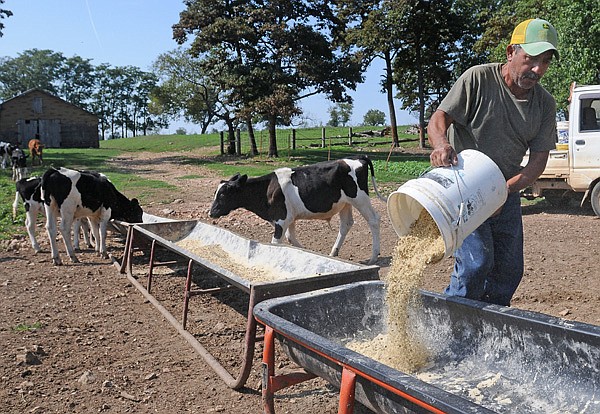BENTONVILLE — Dairy farmers have had a rough go of it in recent years. A succession of dry years, high grain prices and an ailing economy have all taken their toll on a sector with an already thin profit margin.
Recent news of the closure of one of the few dairy processing plants in the state couldn’t seem to come at a worse time. But those in the industry are optimistic the closing of Kraft Foods in Bentonville won’t impact local farmers.
“I’m upset that we’re losing a local business and those 60 jobs,” said Ryan Anglin, a third-generation dairy and beef farmer in Bentonville. “But the reality is, most of our milk goes to Hiland Dairy in Fayetteville. Most of the milk for Kraft comes from out of state.”
Any dairy farmers affected by the plant closure can work with their dairy cooperative to find alternative markets, Anglin said. Other potential buyers in the state include Hiland Dairy plants in Fayetteville and Fort Smith, a Kraft plant in Fort Smith and Coleman Dairy in Little Rock. Springfield, Mo., is also home to several processing plants.
“When you’re part of a co-op, you will have a market for your milk,” Anglin said. “You won’t be dumping milk on the ground.”
By The Numbers
Arkansas Dairy Farming
- 130: Number of dairy farms in Arkansas
- 44: State ranking for dairy production
- 5: Gallons of milk produced by an Arkansas dairy cow each day
- 17.9 million: Gallons of milk produced annually in state
- 98: Percentage of Arkansas farms owned by families
- $29 million: Money generated in Arkansas by milk sales each year
Source: Midwest Dairy Association
Joyce Hodel with Kraft Foods said the company receives its milk through a contract with the Dairy Farmers of America. She was not sure how much of the milk came from local farms.
Dairy farmers in Northwest Arkansas likely won’t have difficulty finding a buyer, according to Floyd Wiedower with the Arkansas Dairy Cooperative. Dairy farmers across the state fall far short of the amount of milk needed to supply its milk processing plants.
In 2009, Arkansas dairy farmers produced around 20 percent of the milk required by processors and less than 15 percent of the milk consumed in the state, according to the Encyclopedia of Arkansas.
That wasn’t always the case. Until the late 1980s, production of milk in the state was about equal to the amount needed by processors, according to the Encyclopedia of Arkansas. Northwest Arkansas has historically been a haven for the state’s dairy farmers. Its rolling hills make it less appropriate for row crops, but provide good pasture land for dairy herds.
Dairy farming changed dramatically between 1989 and 2009, with the state’s 852 dairy farms dwindling to just 140 farms. Factors in the dramatic decline included environmental challenges, deregulation of the industry and a federal herd buyout program. The deregulation decreased Arkansas milk prices to a level on par with those in dairy boom states in the Midwest.
Lower prices and higher operation costs have driven many out of the industry, according to Bruce Tencleve with Farm Bureau.
“What you get for your milk is not near enough to offset the input cost,” Tencleve said.
Several years of drought pushed grain prices skyward, and farmers without means to grow their own feed faced tough choices, Tencleve said. Many ended up dipping into savings and are just trying to grit out the rough period.
“We’ve been riding the downside of dairy for a while now,” Tencleve said. “Farmers have been digging into their back pockets, but there’s not a whole lot left there, unfortunately.”
Anglin said farmers also took a big hit from the economic downturn. He said dairy farmers were underselling domestically, and the export market dried up as the economic stumble went global.
“People cut back,” Anglin said. “That extra slice of cheese on a hamburger was something they didn’t have to have.”
The state has tried to address the problems of dairy farmers through new programs. Arkansas created the Milk Stabilization Board in 2007 to ensure an adequate milk supply in the state, and the state Legislature passed a two-year program in 2009 to provide incentives to dairy farmers.
The University of Arkansas Division of Agriculture has launched a dairy support team to help the state’s farmers.
“The Arkansas dairy industry is an important component of the Arkansas agriculture livestock segment,” said Tom Troxel, associate head of animal science. “Arkansas dairy farms are family-owned, and oftentimes the ownership of these farms spans many generations. We don’t want to lose them.”
Anglin thinks the state needs a fresh crop of young farmers. He said young people, even those who grow up on farms, aren’t coming back to agriculture in adequate numbers. Land prices are high, the work is hard, and environmental regulations are prohibitive, he said.
Tencleve said he hopes dairy farmers, young or old, can ride out the rough patch.
“I’m just hoping and praying for a stronger day to come,” he said.

